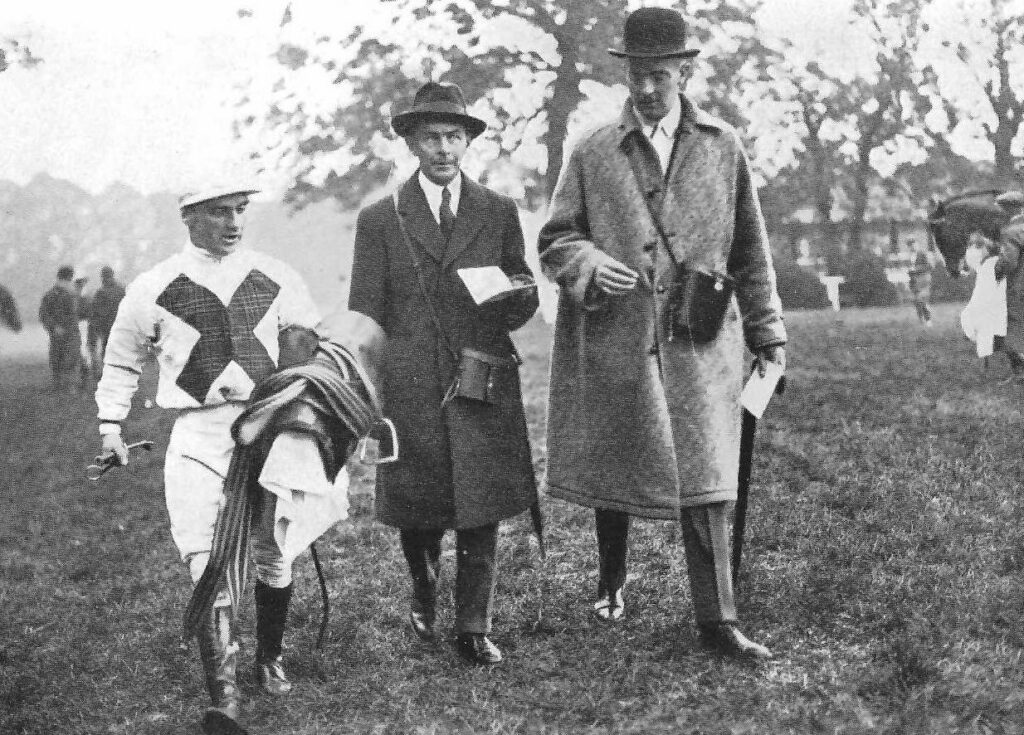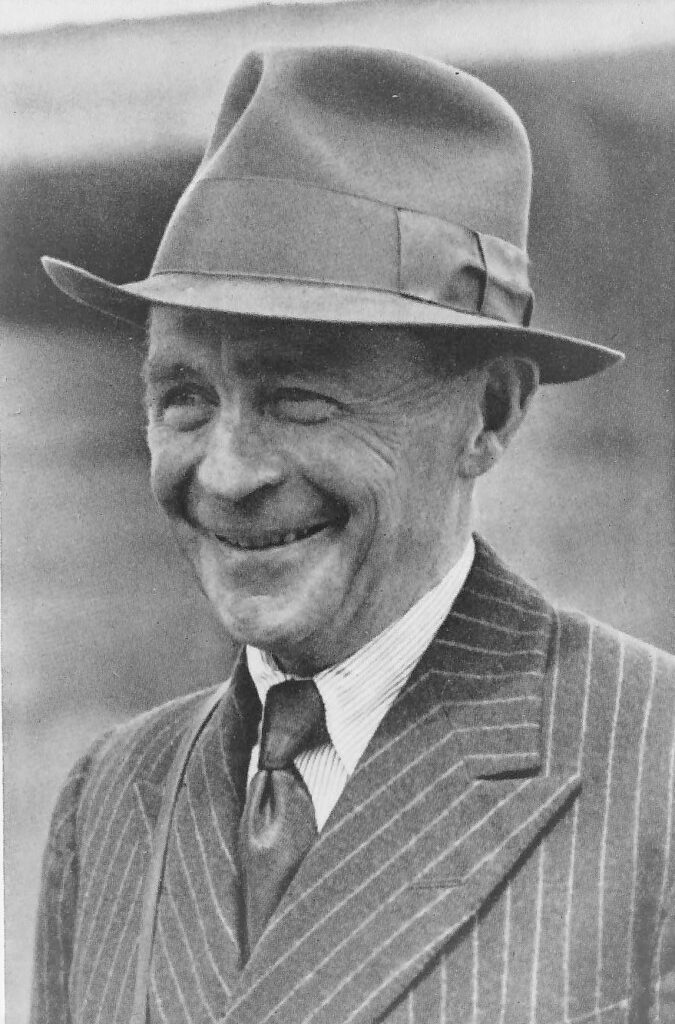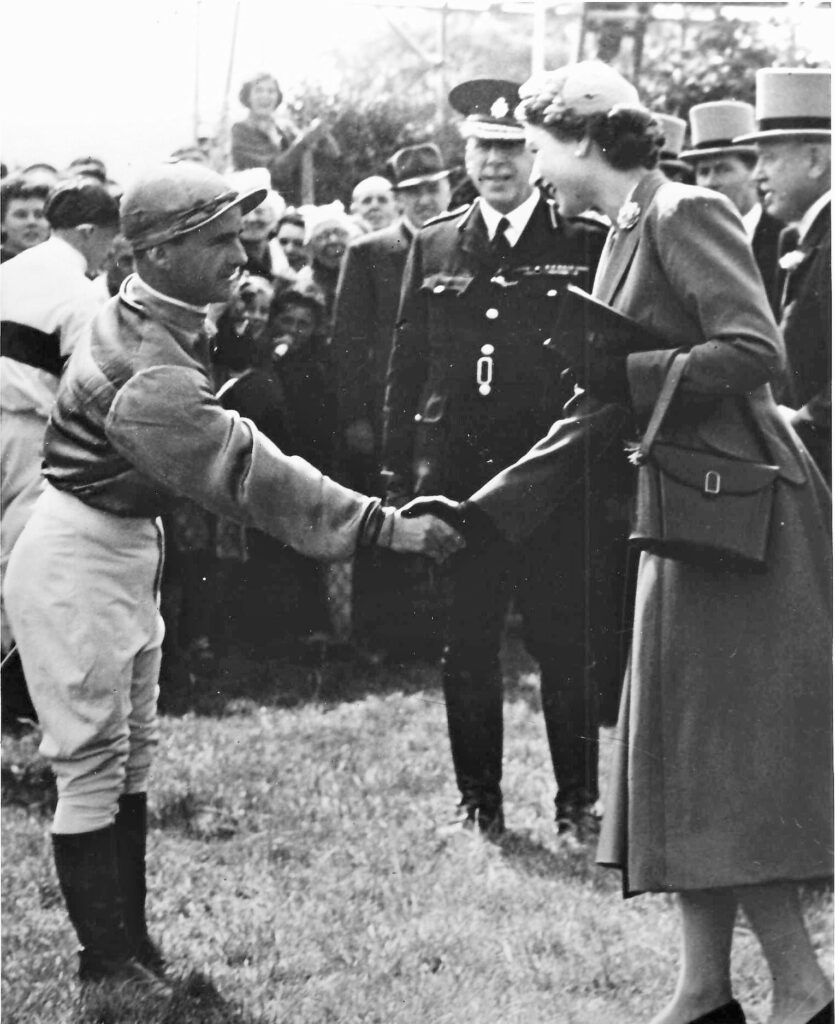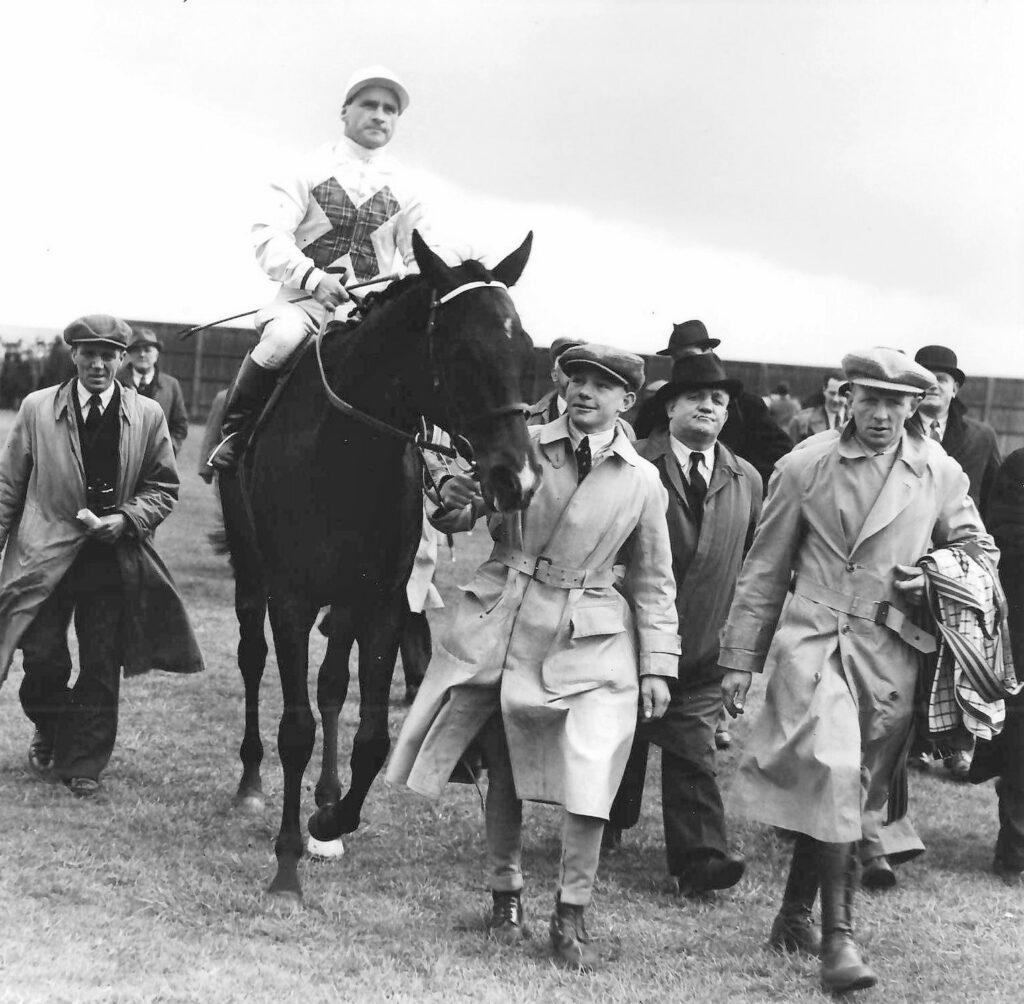Sir Gordon Richards, Fred Darling and John Arthur Dewar
Above: Gordon, Fred Darling and Lord Dewar
Sir Gordon Richards (1904-1986)
Gordon was born at Donnington Wood, near Oakengates in Shropshire, as one of a family of 12 children, where his father was a coal miner. Gordon served his apprenticeship with Martin Hartigan at Foxhill and rode his first winner on Jimmy White’s Gay Lord at Leicester on 16 October, 1920. He was Champion Jockey for the first time in 1925 and, in 1933, made the front pages of every Daily newspaper when beating Fred Archer’s record of 146 winners in a season.
A modest, dedicated man of great integrity, Gordon Richards was the undisputed hero of those who followed racing for the first half of the 20th century, and his Derby victory on Pinza the most popular of that period. Lord Rosebery said of him, “The greatness of Gordon Richards lay not in his having won so many races but in his having lost so few that he ought to have won.”
In 1954, when leaving the paddock at Sandown, the filly Abergeldie reared up and fell over backwards on top of Richards, breaking his pelvis and dislocating four ribs. The following year, fully recovered, he trained from Beckhampton, later moving first to Ogbourne-Maizey and then to Whitsbury in Hampshire, with Scobie Breasley as stable jockey.
Gordon Richards was Champion Jockey 26 times and from 21,834 mounts rode 4,870 winners. His 14 Classic winners included, Rose of England (1930 Oaks), Sun Chariot (1942 Fillies’ Triple Crown), the brilliant Tudor Minstrel (1947 Two Thousand Guineas) and Pinza (1953 Derby).
Fred Darling (1884-1953)
The son of the Beckhampton trainer, Samuel Darling, who trained Galtee More to win the Triple Crown in 1897. Fred, not having made the grade as a jockey, took to training a few horses for the actress Lilie Langtry at Kentford, near Newmarket, and won the 1908 Cesarewitch for her with the 4-y-o Yentoi. In 1909, he went to Germany to train for the Weinberg brothers, until, on the retirement of his father in 1913, he returned to take over the Beckhampton stable in Wiltshire. From there, with an instinctive understanding of his horses, he was Champion Trainer six times, sending out 19 Classic winners, including two war-time winners of the Oaks and seven Derby winners: Captain Cuttle (1922), Manna (1925), Coronach (1926), Cameronian (1931), Bois Roussel (1938), Pont l’Eveque (1940) and Owen Tudor (1941).
Notably, his three best horses were the unbeaten Hurry On (1916 St Leger), Sun Chariot (1942 fillies’ Triple Crown) and Tudor Minstrel, heralded in the Press as “the horse of the century”, after his eight-length victory in the 1947 Two Thousand Guineas.
His training method was to conserve the greater part of the horses energy for the racecourse. As a result, his horses always looked robust and carried a condition known as the ‘Beckhampton bloom.’ A martinet with his staff, both in the yard and on the gallops, he was described as a dapper little man with a tight thin-lipped mouth. Sadly, he made no friends and would regularly thwart his owner’s wishes and requests to see their horses in training – a situation they grew to accept.
He did, however, have a great admiration for Gordon Richards, his stable jockey for 16 years. Gordon said in his autobiography, “I don’t think Mr Darling ever understood friendship at all,” and admitted he could be “absolutely ruthless,” nevertheless, he said, “I unhesitatingly describe him as a genius. There has been no trainer like him, and there never will be another.”
In 1953, Darling, having bred Pinza, and now in failing health, was happy for him to go to his former head lad, Norman Birtie. Too weak to go to the Derby, he listened to the race on the radio, finally letting go, he died three days later.
Sir Gordon congratulated by the Queen after winning the Derby on PINZA in 1953
John Arthur Dewar (1891-1954)
On the death of his uncle, the 1st Baron Dewar in 1930, John Arthur Dewar inherited a large part of his great fortune made from the Dewar whisky distillery. John also inherited the Baron’s string of racehorses and his famous colours: ‘white, tartan cross back and front’. Following victories with Cameronian in the 1931 Two Thousand Guineas and Derby, he became known as ‘Lucky’ Dewar. Classic success continued with Commotion (1941 Oaks), Tudor Minstrel (1947 Two Thousand Guineas by eight lengths and top of the Timeform ratings until Sea-Bird in 1965), then finally with Festoon (1954 One Thousand Guineas).
Having served with the Argyll and Sutherland Highlanders during the First World War, he later turned his attention to racing and breeding. Elected to the Jockey Club in 1941, he carried on from his uncle with Fred Darling as trainer until the latter’s retirement in 1947, whereupon he purchased the Beckhampton stables and brought in Noel Murless (later Sir Noel) as his trainer. After Murless moved to Newmarket in 1952, Dewar sent his string to Noel Cannon at Druids Lodge on Salisbury Plain. From there, Cannon trained Festoon to win her Guineas shortly before Dewar’s death. The dispersal sale of his bloodstock totalled a record 398,595 guineas, exceeding the previous 1925 record for Sir Edward Hulton’s bloodstock by more than 100,000 guineas.
John Arthur Dewar’s Tudor Minstrel (Sir Gordon up) return in triumph, after winning the Two Thousand Guineas
For more Racing History see Michael’s Books for Sale.



